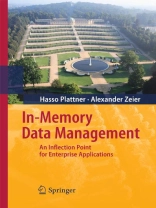In the last 50 years the world has been completely transformed through the use of IT. We have now reached a new inflection point. Here we present, for the first time, how in-memory computing is changing the way businesses are run. Today, enterprise data is split into separate databases for performance reasons. Analytical data resides in warehouses, synchronized periodically with transactional systems. This separation makes flexible, real-time reporting on current data impossible. Multi-core CPUs, large main memories, cloud computing and powerful mobile devices are serving as the foundation for the transition of enterprises away from this restrictive model. We describe techniques that allow analytical and transactional processing at the speed of thought and enable new ways of doing business. The book is intended for university students, IT-professionals and IT-managers, but also for senior management who wish to create new business processes by leveraging in-memory computing.
Table des matières
Foreword by Prof. John L. Hennessy (Stanford University, California, USA) and Prof. David A. Patterson (University of California at Berkeley, USA). – Preface . – Introduction. – PART I – An Infl ection Point for Enterprise Applications . – 1 Desirability, Feasibility, Viability – The Impact of In-Memory . – 2 Why Are Enterprise Applications So Diverse? . – 3 Sanssouci DB –Blueprint for an In-Memory Enterprise Database System . – PART II – Sanssouci DB – A Single Source of Truth through In-Memory. – 4 The Technical Foundations of Sanssouci DB . – 5 Organizing and Accessing Data in Sanssouci DB .- PART III – How In-Memory Changes the Game . – 6 Application Development . – 7 Finally, a Real Business Intelligence System Is at Hand .- 8 Scaling Sanssouci DB in the Cloud . – 9 The In-Memory Revolution Has Begun . – References . – Glossary . – Abbreviations . – Index
A propos de l’auteur
Prof. Dr. h.c. Hasso Plattner is a co-founder of SAP AG, where he served as the CEO until 2003 and has since been chairman of the supervisory board. SAP AG is today the leading provider of enterprise software solutions. In his role as chief software advisor, he concentrates on defining the mid- and long- term technology strategy and direction of SAP. Hasso Plattner received his diploma in communications engineering from the University of Karlsruhe. In recent years, he has been focusing on teaching and research in the field of business computing and software engineering at large. In 1998, he founded the Hasso-Plattner-Institute (HPI) in Potsdam, Germany. At the HPI, approximately 480 students are currently pursuing their Bachelors’ and Masters’ degrees in IT Systems Engineering with the help of roughly 50 professors and lecturers. The HPI currently has about 100 Ph D candidates. Hasso Plattner leads one of the research groups at HPI which focuses mainly on In-Memory Data Management for Enterprise Applications and Human-Centered Software Design and Engineering.
Dr. Alexander Zeier graduated from the University of Würzburg in business management and successfully completed his studies in information technology at the Technical University of Chemnitz. He worked for a few years as a strategic IT consultant, before gaining his doctorate in Supply Chain Systems at the University of Erlangen-Nuremberg. He has 19 years experience with SAP/IT Systems and started working for SAP in 2002 as product manager with overall responsibility for the SCM Software, SAP`s first large In-Memory Application. Since 2006 he has been Deputy Professor of Prof. Hasso Plattner at the Hasso Plattner Institute in Berlin/Potsdam focusing on real-time In-Memory Enterprise Systems and RFID Technology. He is the author of more than 100 publications, including five books on IT and SAP. He is the Executive Director of the European Section of the MIT Forum for Supply Chain Innovation and Visiting Professor at MIT.












